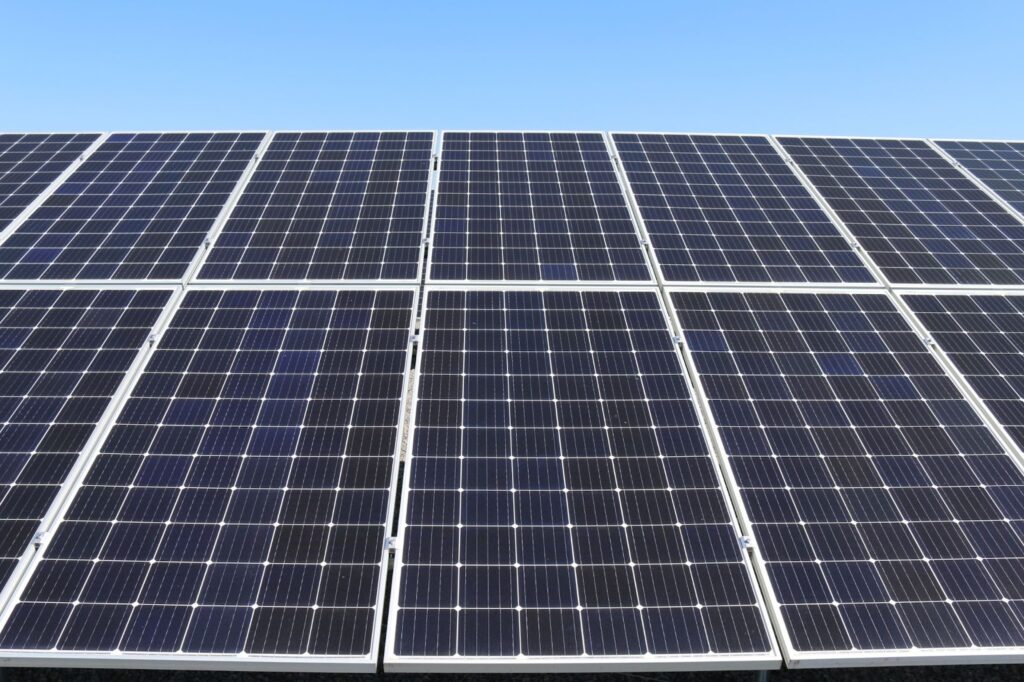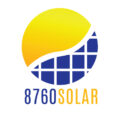
When you break it down, solar energy has a lot of technical terms, and solar panels are no exception. There are several types of solar panels that you might want to consider, each with its own unique set of characteristics.
In this article, we’re going in-depth on monocrystalline solar panels – the most popular option available on the market today.
Here’s everything you need to know about them.
In a Nutshell
- Monocrystalline solar panels are constructed from a single piece of high-grade silicon.
- Monocrystalline offers the highest efficiency and longevity compared with other panel types.
- Three variations of monocrystalline panels exist – bifacial, PERC, and HJC.
- Bifacial are double-sided panels that absorb both direct and reflected indirect sunlight.
- Bifacial solar panels are an excellent choice for farms and agrivoltaics systems.
- PERC panels feature an additional reflective layer, which increases the efficiency rate by up to 24%.
- HJC panels use amorphous silicon layers and are cheaper to manufacture while offering the highest efficiency rates of 25%+.
Monocrystalline Solar Panel Features at a Glance

| Solar panel type | Typical warranty | Average lifespan | Efficiency range | Watt capacity |
| Monocrystalline | 25 years | 25 – 40 years | 15% – 20% | 250 – 340 watts (60 cell panel) |
| Passivated Emitter and Rear Cell (PERC) | 25 years | 25 – 30 years | Up to 24% | 300 – 400 watts (60 cell panel) |
| Bifacial | 25 years | 35 – 40 years | 22% – 23% | 300 – 500 watts (60 cell panel) |
| Heterojunction Solar Cells (HJC) | 25 years | 35 – 40 years | Up to 25% | 300 – 330 watts (60 cell panel) |
The average cost of monocrystalline solar panels is $1 to $1.50 per watt, with an extra 10 – 20 cents added per watt for bifacial designs.
The average cost of a 10kW system is $10,000 – $15,000, depending on the type of monocrystalline panels you choose.
What Are Monocrystalline Solar Panels?

Monocrystalline solar panels are a specific type of solar panel renowned for their performance and high efficiency. These panels are characterized by their solid inky black color and are more expensive to buy than other types of solar panels.
Despite their cost, they are one of the most popular solar panel types available on the market today.
They have a wide range of applications and you will see them in all types of solar installation, from residential to commercial and even utility-scale solar farms.
How Are Monocrystalline Solar Panels Made?

Monocrystalline solar panels are named as such because the photovoltaic wafers inside the panel are created from a single piece of silicone.
To do this, the silicone undergoes an energy-intensive – and costly – manufacturing process called the “Czochralski method.”
Invented in 1916 by Jan Czochralski. The Czochralski method consists of a crystal growth technology that uses high-grade and purity silicone crystals.
To start, a single crystal (known as a “seed”) is placed in a crucible and heated to 2573.6°F, at which point it melts. Then, a second solid seed crystal is rotated and dipped into the melted silicone and pulled in an upward motion.
As the silicone is being pulled, it cools and hardens to form solid cylindrical ingots of silicone.
Once the ingots are fully hardened, they are sliced into octagonal-shaped wafers or “cells” that are a mere 160 microns thick.
Then, the wafers are laid in a grid pattern to form a rectangular sheet, which is then covered in special coatings and protective glass, and fixed in place with an aluminum frame.
A single solar panel can contain between 32 to 96 of these wafers, depending on its size.
How Do Monocrystalline Solar Panels Work?

The monocrystalline silicon cells are the components in the solar panel that transform sunlight into electrical energy.
As light falls onto the surface of the solar panel, the light photons connect with the solar cell’s silicon atoms. This causes electrons to be released, which are captured by the wire circuitry connected to the cells.
As more electrons are gathered, an electrical current is generated, which flows through the electrical system and can be used to power electrical devices. If any excess power is generated, it can be stored in a battery or sent to the grid.
How Well Do Monocrystalline Solar Panels Perform?
Monocrystalline solar panels are popular for a very good reason. They are capable of capturing around 15% to 20% of light photons.
Their high-efficiency rate is down to the purity of the silicon used and the manufacturing process that ensures a uniform structure is achieved. These two factors allow more electrons to flow through the solar panel and be captured for use.
Additionally, monocrystalline solar panels are highly durable and have excellent longevity. Their warranties will typically range between 20 – 25 years, though it is very common for the panels to actually last a lot longer than this, even if their efficiency drops a little.
What Types of Monocrystalline Solar Panels Are Available?

Besides the standard monocrystalline solar panel, there are several variations available, each with its own characteristics and advantages.
Bifacial Panels
Bifacial panels are so-called because they feature a double-sided face. You have the main surface of the panel that faces the sun and captures the direct sunlight that hits it.
Then you have the underside of the panel that also has photovoltaic cells that capture light and transform it into electricity.
You may be wondering how this is possible. Well, rather than capture the direct light, the underside does a great job of capturing the indirect light that reflects off the ground.
This setup provides you with increased efficiency when compared with single-sided monocrystalline panels and can achieve rates of 22% – 23%.
Because of their double-sided nature, bifacial panels require a special racking system that raises them high enough off the ground to capture the indirect light.
While this makes them entirely unsuitable for most roof-mounted systems or where the panels need to be mounted flush against a surface, they are an excellent choice for ground-mounted installations.
Additionally, raising the panels higher off the ground provides more room underneath them, which paves the way for the possibility of agrivoltaics (where crops are cultivated underneath the panels) or sheep grazing.
Therefore, bifacial monocrystalline solar panels are an excellent choice for farmers and agricultural businesses that want to go solar.
To further increase efficiencies, bifacial solar panels can incorporate either of the technologies mentioned below.
Passivated Emitter and Rear Cell Panels (PERC)
PERC solar panels are an upgraded version of standard monocrystalline panels.
They feature an additional reflective layer that is fixed to the back of the panel. Called a “passivation” layer, it acts just like a mirror and reflects the unused light photons back through the panel, where they are captured and transformed into electricity.
This passivation layer also helps prevent rear recombination, which would otherwise impair the panel’s performance when it starts to get too hot.
PERC solar panels are suitable for all types of solar installation and have an incredible efficiency rate of up to and over 24%. However, because of the improved technology of this panel type and the additional and complicated steps in the manufacturing process, they, of course, are more expensive to buy.
Heterojunction Solar Cells (HJC)
HJC solar panels are an emerging technology that will no doubt overtake other types of crystalline solar panels in popularity. This is because they offer the highest efficiency rate of all and are less expensive and complicated to manufacture than traditional monocrystalline panels.
HJC panels are monocrystalline panels with additional layers created from something called “amorphous silicon” or “a-Si.” This is a thin-film type of flexible silicon already commonly used in consumer electronics such as LCD TVs.
Each monocrystalline layer is sandwiched between two layers of the a-Si silicon. The top layer of a-Si captures the light photons before they hit the monocrystalline layer. It is also capable of capturing any light that reflects back off the subsequent layers. The rear layer of a-Si captures any residual photons that the first layer of a-Si and the monocrystalline layer misses.
With so many layers working to capture light photons, this results in an efficiency rate of over 25% when combined with a bifacial design.
HJC panels also do very well in hot climates thanks to their increased tolerance for high temperatures, and their additional layers make them particularly good in low light conditions.
Furthermore, the amorphous silicon acts as a protective barrier to the monocrystalline, helping prevent degradation and damage. As such, HJC panels have a super long lifespan of 30+ years.
When manufacturing HJC panels, there are fewer processes involved when compared with PERC monocrystalline modules. Therefore, it is cheaper and easier to make HJC panels, which results in a lower retail cost.
The Pros and Cons of Monocrystalline Solar Panels

| Monocrystalline solar panels pros | Monocrystalline solar panels cons |
| High-efficiency rates – the best of all solar panel types High efficiency means fewer panels are required overall for an installation Excellent longevity with warranties lasting between 20 – 25 years The panels perform very well in low-light conditions Due to the construction methods used, monocrystalline panels are more compact in size and lighter in weight The panels have a good heat tolerance and can withstand temperatures up to 149 °F before they start to drop in performance As HJC bifacial panels become commonplace, the price of this extremely efficient technology will drop | Monocrystalline solar panels are the most expensive option on the market The manufacturing process is costly because it results in a lot of wasted silicon Monocrystalline does not perform well in low-temperature conditions and may not perform at all if the temperature drops too much |
Should I Buy Monocrystalline Solar Panels?

In a word, yes! We always recommend opting for monocrystalline over polycrystalline solar panels.
Why?
Monocrystalline is superior to polycrystalline. It has higher efficiency rates, so it will generate more electricity, and it has better longevity, so it will generate electricity for you over a longer period of time.
And even though they cost more upfront, they are going to save you more in the long run.
Our advice is to go for the best solar panels that your budget will allow, whether that’s PERC, bifacial, HJC, or a combination of these technologies. You will thank yourself when your panels can easily manage your electricity needs over the coming decades.
Talk to 8760 Solar
If you are interested in switching to solar, then talk to our team at 8760 Solar. We specialize in providing solar installations for farms and agricultural businesses. We’re experienced experts and are perfectly placed to advise you on the best types of solar panels for your business.
Our suppliers GreenTech Renewables and Trina Solar provide us with top-of-the-line equipment, including high-performing monocrystalline panels.
To start your solar journey, text “READY” to 719 470-0254 or contact us via email: sales@8760solar.com. We’re looking forward to talking with you.
Frequently Asked Questions
Are Monocrystalline Solar Panels Better?
Monocrystalline solar panels offer the highest efficiency rates of all solar panel types. If you choose bifacial, heterojunction solar cells (HJC), or passivated emitter and rear cell panels (PERC), then you will get even greater efficiency rates.
What Are the Disadvantages of Monocrystalline Panels?
The main disadvantage of monocrystalline solar panels is the cost. Because the manufacturing process is difficult and high-grade silicone is used, the panels are more expensive to buy.
Do Monocrystalline Solar Panels Work at Night?
Like all other types of solar panels, monocrystalline solar panels require sunlight to work. Therefore, they are not able to operate when it is dark.
What Is the Difference Between Photovoltaic and Monocrystalline?
Photovoltaic refers to the cells that are used to capture sunlight and convert it into energy. Monocrystalline refers to the material and process that is used to create the photovoltaic cells.
Does Tesla Use Monocrystalline Solar Panels?
Yes, all solar panels and solar roof tiles manufactured by the brand Tesla are made using monocrystalline photovoltaic cells.
What Is the Life Expectancy of a Monocrystalline Solar Panel?
The life expectancy of monocrystalline solar panels is excellent. While the typical warranty of a monocrystalline panel will be 20 – 25 years, the panels can and often last much longer than this.
